
Starting Thursday, March 7, Sonos will start shipping the second generation of its Alexa-enabled smart speaker, the Sonos One. It will be equipped with an updated processor, increased memory, four far-field microphones instead of the six mics the first gen had, and somewhat surprisingly, Bluetooth Low Energy (BLE).
Bluetooth in a Sonos product? It’s actually not the first time. The Sonos Beam has BLE too. But before your head explodes at the idea that Sonos might be walking back from its 15-year exclusive commitment to Wi-Fi as its audio transport technology of choice, it’s unlikely this addition means Sonos is about to support Bluetooth streaming. A company spokesperson told Digital Trends that BLE will be used “to temporarily communicate with your phone/tablet to simplify the first-time setup process.” They further noted that, “there are no changes to the design and features available for customers,” which makes sense. Bluetooth Low Energy is a different kind of Bluetooth from the one that supports wireless headphones, and there is currently no officially supported way for it to carry audio or voice. The technology tends to be used for other purposes, like mesh networking (something Sonos already does via Wi-Fi) and other applications that require constant, but low bandwidth data transmission, like fitness and healthcare monitoring devices.
As much as an easier setup is a good thing, we can’t help but speculate on other uses for BLE. After all, Sonos already has one of the easiest and quickest set-up procedures we’ve ever experienced. Does it really need to add a new BLE radio for a task most users will only perform a handful of times? A quick look at BLE’s features and benefits might yield some clues as to other possible future uses. Support for BLE has been baked into mobile devices for a long time and has been a feature of nearly every iOS and Android phone and tablet since iOS 5 and Android 4.3. Apple uses it as the basis of its iBeacon technology, which lets retailers and other businesses accurately track the location of iPhones through proximity sensing. Sonos could use this aspect of BLE to know when a Sonos user is nearby a Sonos One, and automatically play music based on that person’s preferences. The same principles could be used to enable a “follow me” mode, where music playback begins in one room, but then automatically switches to another location as the user moves around a home — no interactions with the speaker or the app required.
Another possibility is that it could be used as part of a larger smart home feature. BLE can be used to communicate with environmental sensors, and though it seems incongruous with Sonos’ pure music-based strategy, you never know what larger partnerships it might be working on with Apple, or others.
Regardless of where and how BLE will be used, Sonos tells us both generations of the Sonos One will continue to be supported through regular updates.
Updated to reflect the fact that the Sonos Beam also has BLE, and that the Gen 2 model only has four microphones.



